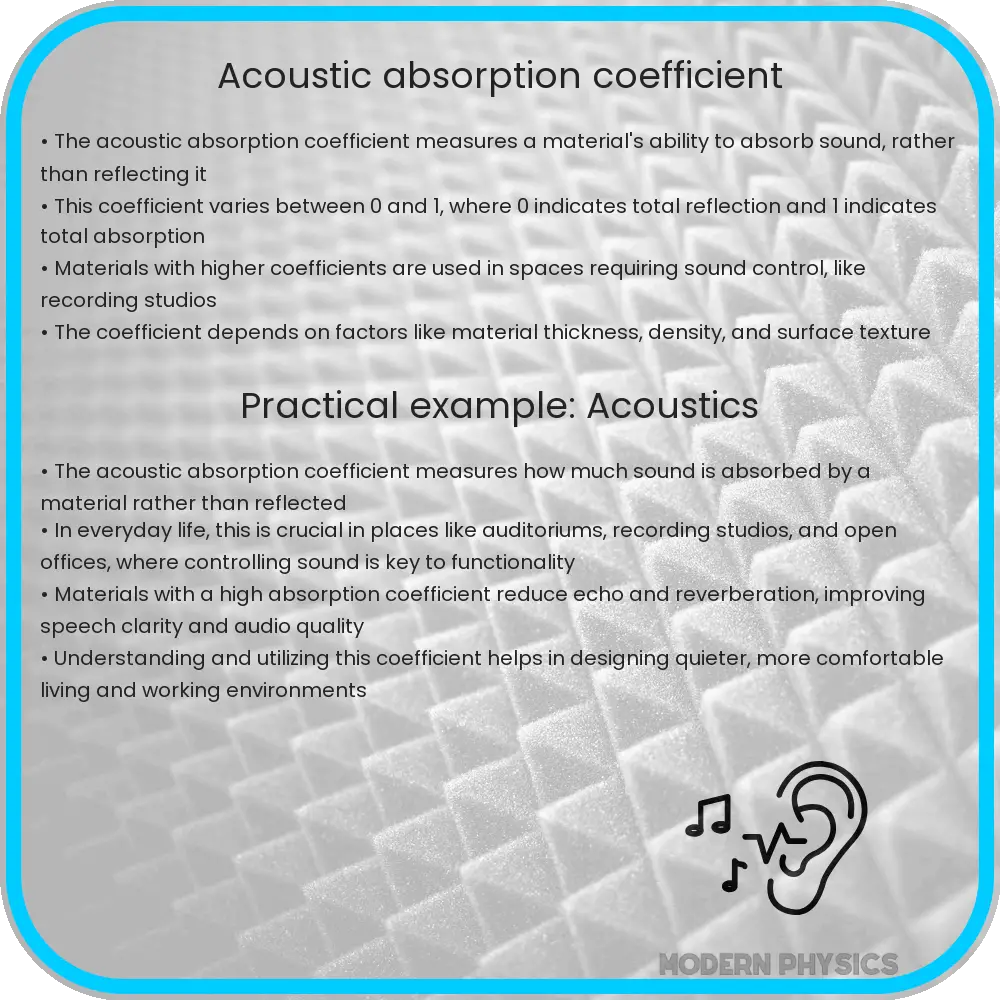The acoustic absorption coefficient measures how effectively a material can absorb sound, impacting noise control and sound quality in various environments.

Understanding the Acoustic Absorption Coefficient
The acoustic absorption coefficient, often symbolized by the Greek letter α (alpha), is a critical parameter in the field of acoustics. It measures how effectively a material can absorb sound. This coefficient is crucial not only in determining the acoustic properties of materials but also in the design and optimization of spaces to improve sound quality. Understanding and applying this coefficient can significantly impact noise control, speech clarity, and overall acoustic comfort in various environments such as theaters, studios, and office spaces.
Basics of Acoustic Absorption
When sound waves encounter a surface, several things can occur: reflection, absorption, and transmission. The acoustic absorption coefficient is concerned primarily with absorption—the process by which a material converts sound energy into heat energy or other forms of energy, thereby reducing the amount of sound reflected back into the space.
The value of α ranges from 0 to 1, where 0 indicates total reflection (no absorption) and 1 indicates total absorption (no reflection). For instance, a coefficient of 0.15 means 15% of the incoming sound energy is absorbed, while the remaining 85% is either reflected or transmitted.
Factors Affecting Acoustic Absorption
Several factors influence the effectiveness of a material’s sound absorption ability:
- Material Composition: Porous materials like foam or fibrous assemblies typically exhibit higher absorption coefficients because they allow sound waves to enter them, dissipating the sound energy within their structure.
- Surface Texture: Rough or irregular surfaces tend to absorb more sound than smooth surfaces due to increased surface area and the potential for sound wave trapping.
- Thickness and Density: Generally, thicker materials absorb sound better at lower frequencies, while density impacts the absorption primarily at higher frequencies.
- Frequency of the Sound Wave: Materials do not absorb all frequencies equally. For example, thick curtains may absorb high frequencies well but do little to mitigate lower frequencies like bass sounds.
Measurement of Acoustic Absorption Coefficient
To measure the acoustic absorption coefficient, a standardized method such as the reverberation room method or the impedance tube method is used. Both approaches provide a way to quantify how much sound is absorbed by testing samples in controlled environments:
- Reverberation Room Method: This method involves measuring the reverberation time (the time it takes for sound to decay by 60 decibels) in a room before and after the test material is added. The difference in reverberation times helps determine the material’s absorption coefficient.
- Impedance Tube Method: Also known as the Kundt’s Tube method, this technique involves sending a known sound wave through a tube where the sample material is placed at one end. The sound waves that are reflected back by the material are analyzed to compute the absorption coefficient.
Data obtained from these measurements can then be used to optimize the acoustic properties of materials and design better acoustic environments. This process is crucial in scenarios where specific sound characteristics are desired for functionality and aesthetic purposes such as concert halls, recording studios, and public speaking venues.
Real-World Applications of Acoustic Absorption
The practical application of the acoustic absorption coefficient is enormous across various industries and disciplines. In architectural acoustics, for example, engineers use knowledge of materials’ absorption coefficients to design spaces that minimize echo and reverberation, enhancing speech intelligibility and audio quality. In automotive engineering, manufacturers apply absorbent materials within the cabin to reduce noise from the engine and the roadway, providing a quieter and more pleasant driving experience.
Similarly, in product design, understanding and manipulating the absorption coefficients of materials can lead to the development of quieter appliances, machinery, and consumer electronics by effectively managing unwanted noise.
Each of these applications not only contributes to functionality but also improves comfort and user satisfaction, highlighting the significance of acoustic treatment in modern design and engineering.
Acoustic Absorption in Environmental Engineering
In addition to its wide-ranging applications in architectural and automotive design, the acoustic absorption coefficient plays a crucial role in environmental engineering. By strategically using materials with high absorption coefficients, engineers can mitigate noise pollution in urban areas, which contributes to environmental noise reduction and enhances the quality of life for city dwellers.
For example, installing noise barriers along highways made from materials with high absorption coefficients can significantly reduce the amount of traffic noise that reaches residential neighborhoods. Similarly, the use of absorbent materials in airport design can help minimize the impact of aircraft noise on nearby communities.
Enhancing Learning Environments through Acoustic Design
Another critical application of the acoustic absorption coefficient is in the design of educational facilities. Schools and universities can benefit greatly from optimized acoustic environments. Classrooms designed with materials that have appropriate absorption characteristics ensure that students can hear their instructors clearly, which is essential for effective learning and comprehension.
Materials like acoustic ceiling tiles and carpeted floors can substantially absorb unwanted sounds, reducing reverberation and echo within a classroom setting. This careful consideration of acoustic properties in educational design helps reduce distractions and fosters a better learning atmosphere for both students and teachers.
Conclusion
Understanding the acoustic absorption coefficient, α, is foundational in the fields of acoustic engineering and design. By quantifying how effectively different materials absorb sound, professionals can make informed choices in the construction and design of spaces to optimize sound quality and enhance functional performances. From improving public spaces and workplaces to creating serene homes and efficient learning environments, the strategic application of this knowledge touches numerous aspects of everyday life.
In conclusion, the acoustic absorption coefficient not only informs the design of more pleasing and functional spaces but also contributes significantly to our overall environmental and psychological well-being. It exemplifies how targeted scientific knowledge and engineering practices can work jointly to solve practical challenges and enhance human experiences in numerous innovative ways.
